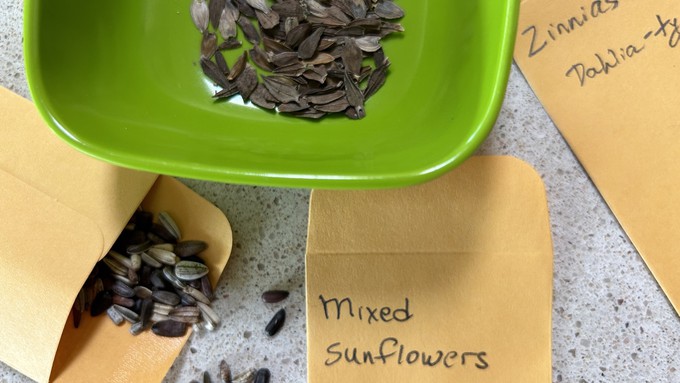
Share seeds with other gardeners and bring home some for your own garden, too

Coin envelopes are convenient storage for extra seeds to swap or save. Label with the year collected or purchased as well as the variety of seed. Kathy Morrison
Got more seeds than you know what to do with – and still need more?
Here’s an opportunity to share that wealth while also filling your own garden with varieties you haven’t yet grown.
On Saturday, Jan. 27, the Fair Oaks Branch Library will host “Sacramento Seed Swap and Share,” a local celebration of National Seed Swap Day.
From 1 to 3 p.m., the public is invited to bring vegetable, flower and herb seeds to this free event to swap with other gardeners – or just to share. The seed should come from non-hybrid varieties such as heirloom tomatoes, squash or beans. It can be seed saved from the grower’s own garden or commercially produced.
“Come trade and share seeds! Save money, reduce waste, and increase biodiversity!” say the organizers. “Bring open-pollinated and/or heirloom vegetable, flower, herb and native plant seeds to share. Leave with new varieties to try. Share knowledge and experience about seed saving and starting plants from seed.”
Held on the last Saturday in January, National Seed Swap Day serves as “a reminder that spring is on the way,” say its creators. For most gardeners, late January is a perfect time to take stock of their seed supply while considering what to grow this spring, summer and fall.
Swapping seeds is as old as farming; so is saving seeds to grow or swap with others. Think of it as green recycling. Not only does seed swapping and sharing increase the diversity of the plants you grow, it saves money, too.
Bring envelopes and a pencil or pen to label your seed acquisitions. Bring your own seeds to swap or share, too.
Fair Oaks Branch Library is located at 11601 Fair Oaks Blvd. in Fair Oaks.
For more details: https://www.facebook.com/events/1789593944880108.
Comments
0 comments have been posted.Sacramento Digs Gardening to your inbox.
Food in My Back Yard Series
May 6: Maintain soil moisture with mulch for garden success
April 29: What's (already) wrong with my tomato plants?
April 22: Should you stock up on fertilizer? (Yes!)
April 15: Grow culinary herbs in containers
April 8: When to plant summer vegetables
April 1: Don't be fooled by these garden myths
March 25: Fertilizer tips: How to 'feed' your vegetables for healthy growth
March 18: Time to give vegetable seedlings some more space
March 11: Ways to win the fight against weeds
March 4: Potatoes from the garden
Feb. 25: Plant a fruit tree now -- for later
Feb. 18: How to squeeze more food into less space
Feb. 11: When to plant? Consider staggering your transplants
Feb. 4: Starting in seed starting
Sites We Like
Garden Checklist for week of May 11
Make the most of the lower temperatures early in the week. We’ll be back in the 80s by Thursday.
* Plant, plant, plant! It’s prime planting season in the Sacramento area. Time to set out those tomato transplants along with peppers and eggplants. Pinch off any flowers on new transplants to make them concentrate on establishing roots instead of setting premature fruit.
* Direct-seed melons, cucumbers, summer squash, corn, radishes, pumpkins and annual herbs such as basil.
* Harvest cabbage, lettuce, peas and green onions.
* In the flower garden, direct-seed sunflowers, cosmos, salvia, zinnias, marigolds, celosia and asters. (You also can transplant seedlings for many of the same flowers.)
* Plant dahlia tubers.
* Transplant petunias, marigolds and perennial flowers such as astilbe, columbine, coneflowers, coreopsis, dahlias, rudbeckia and verbena.
* Keep an eye out for slugs, snails, earwigs and aphids that want to dine on tender new growth.
* Feed summer bloomers with a balanced fertilizer.
* For continued bloom, cut off spent flowers on roses as well as other flowering plants.
* Add mulch to the garden to maintain moisture. Mulch also cuts down on weeds. But don’t let it mound around the stems or trunks of trees or shrubs. Leave about a 6-inch-to-1-foot circle to avoid crown rot or other problems.
* Remember to weed! Pull those nasties before they set seed.
* Water early in the day and keep seedlings evenly moist.